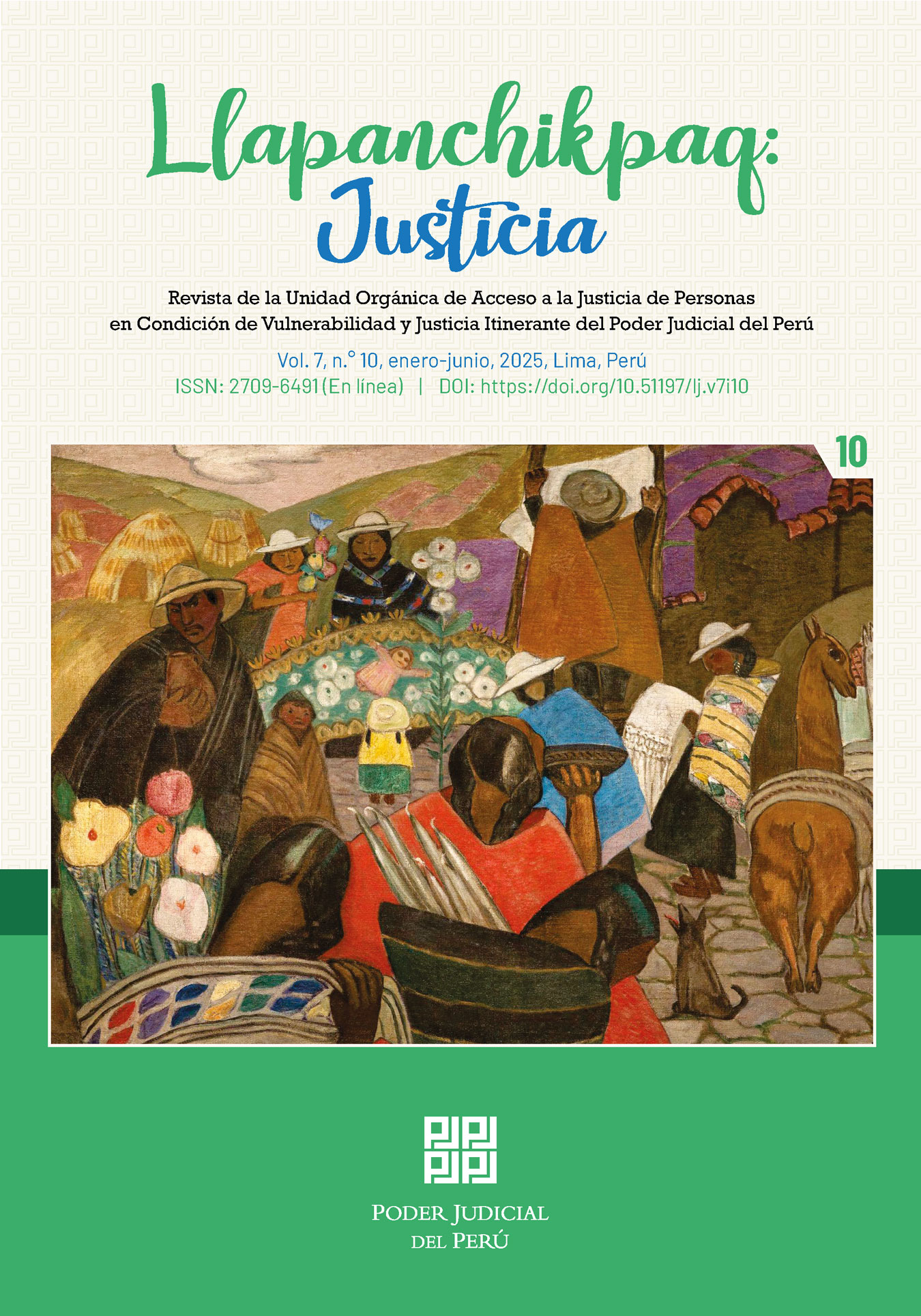O direito ao acesso à internet e suas implicações para o acesso à justiça no Peru
Resumo
Este artigo analisa a conexão entre o direito ao acesso à internet e o direito ao acesso à justiça no Peru, destacando as barreiras enfrentadas pelas populações vulneráveis no contexto da transformação digital do sistema judicial. Analisa-se a internet como um direito humano emergente, essencial para o exercício de outros direitos, e revisase seu reconhecimento no ordenamento jurídico peruano. Por sua vez, aborda-se o direito de acesso à justiça e a importância das 100 Regras de Brasília como marco para identificar os grupos em situação de vulnerabilidade. O estudo afirma que a internet é uma ferramenta fundamental para facilitar o acesso à justiça, mas alerta que a desigualdade digital pode se tornar uma nova forma de exclusão. Por isso, é necessário adotar uma abordagem inclusiva e baseada nos direitos humanos em todo o processo de digitalização judicial.
Downloads
Metrics
Referências
Alva, A. (2015). Los nuevos rostros de la desigualdad en el siglo XXI: la brecha digital. Revista mexicana de ciencias políticas y sociales, 60(223), 265-285. http://www.scielo.org.mx/scielo.php?script=sci_arttext&pid=S0185-19182015000100010&lng=es&tlng=es
Anzures, J. (2020). Naturaleza jurídica y funciones del derecho humano a Internet. Boletín mexicano de derecho comparado, 53(158), 521-552. Epub 14 de enero de 2022. https://doi.org/10.22201/iij.24484873e.2020.158.15628
Batris, A. y Pérez, O. (2022). El acceso a la justicia como un derecho humano en la construcción del Estado de derecho. Revista Lex Mercatoria (20). 1-19. https://revistas.innovacionumh.es/index.php/lexmercatoria/article/view/1775
Campbell, J. (2002). La justicia: Los principales debates contemporáneos. Gedisa Editorial.
Carmen, E. y Carmen, W. (2022). La Red Dorsal Nacional de Fibra Óptica, oportunidad para el impulso de la Investigación y Educación en el Perú. Revista CITEK, (05), 3-9. https://revistas.icte.edu.pe/citek/article/view/28
Chocobar, M. (2022). Política Nacional de Transformación Digital: Aspectos centrales para la equidad digital. IUS ET VERITAS, (65), 41-56. https://doi.org/10.18800/iusetveritas.202202.003
Convención Americana sobre Derechos Humanos (Pacto de San José). Artículo 25. 22 de noviembre de 1969.
Cristallo, J., Lavin, R., Gayraud, F. y Daglio, A. (2023). Transformación digital en el sistema de justicia: Oportunidades para una justicia rápida, accesible y transparente. https://fund.ar/wp-content/uploads/2023/07/Fundar_Transformacion-digital-de-la-justicia.pdf
Declaración Universal de Derechos Humanos. Adoptada y proclamada por la Asamblea General en su resolución 217 A (III), de 10 de diciembre de 1948. https://www.ohchr.org/sites/default/files/UDHR/Documents/UDHR_Translations/spn.pdf
Fernández, E. (2022). Consideración del acceso a internet como un Derecho Humano: avances y perspectivas. Anales de la Facultad de Ciencias Jurídicas y Sociales de la Universidad Nacional de La Plata, 19(52), 117. https://doi.org/10.24215/25916386e117
Figueroa, E. (2022). Transformación digital y pandemia: nuevos paradigmas. Revista Oficial Del Poder Judicial, 14(17), 25-53. https://doi.org/10.35292/ropj.v14i17.570
García, A. (2021). La importancia de las Reglas de Brasilia para un efectivo acceso a la justicia en materia familiar en México. Revista Llapanchikpaq: Justicia, 3(3), 53-76. https://doi.org/10.51197/lj.v3i3.3
Landa, C. (2019). Contenido esencial del Derecho Fundamental al Internet: Teoría y praxis. En Landa et al., Libro homenaje del Área de derecho constitucional por los 100 años de la Facultad de Derecho de la Pontificia Universidad Católica del Perú (pp. 145-173). https://repositorio.pucp.edu.pe/index/handle/123456789/169015
Libaque-Sáenz, C. (2023). Estrategias para reducir la brecha digital en el Perú: lecciones de la República de Corea. Política Internacional, (133), 184-197. https://doi.org/10.61249/pi.vi133.71
Mananí, M. (2024). Derechos digitales de los grupos vulnerables en Perú: un análisis integral. Chornancap Revista Jurídica, 1(2), 111-121. https://doi.org/10.61542/rjch.45
Medina, E. (2022). Hacia una teoría sobre la e-justice o justicia digital: instrucciones para armar. Cuestiones constitucionales, (46), 177-212. Epub 03 de marzo de 2022. https://doi.org/10.22201/iij.24484881e.2022.46.17052
Núñez, J. (2021). Innovación digital en el Poder Judicial en el Perú: aplicación de las nuevas tecnologías. Informática y Derecho. Revista Iberoamericana de Derecho Informático, (2), 11. https://revistas.fcu.edu.uy/index.php/informaticayderecho/article/view/3045
Peña, A. (2012). Barreras de Acceso a la Justicia, y la Justicia Comunal como Alternativa en el Perú. Derecho & Sociedad, (38), 360-368. https://revistas.pucp.edu.pe/index.php/derechoysociedad/article/view/13134
Prince, A. (2020). El acceso a Internet como derecho fundamental: perspectivas internacionales. Revista Justicia & Derecho, 3(1), 1-19. https://doi.org/10.32457/rjyd.v3i1.456
Priori, G. (2019). El proceso y la tutela de los derechos. Fondo Editorial PUCP. https://repositorio.pucp.edu.pe/server/api/core/bitstreams/0cf378fe-5c1b-4d24-95d5-3b3e43bde41d/content
Salas, M. (2022). Transformación digital en el Poder Judicial. https://csjarequipa.pj.gob.pe/main/wp-content/uploads/2022/12/Transformacion-Digital.pdf
Serrano, E. (2005). La teoría aristotélica de la justicia. Isonomía, (22), 123-160. https://www.cervantesvirtual.com/obra/la-teora-aristotlica-de-la-justicia-0/
Sociedad Nacional de Industrias [SNI] (2024). Reporte de pobreza n.º 01-2024. https://sni.org.pe/wp-content/uploads/2024/05/RM-Nro1-2024-Pobreza-monetaria.pdf
Constitución Política del Perú [Const.]. (1993). [texto actualizado con las normas ratificadas en el Referendum de 2018]. 13.ª ed. oficial. https://www.minjus.gob.pe/wp-content/uploads/2018/06/4-Constituci%c3%b3n-Pol%c3%adtica-del-Per%c3%ba-%e2%80%93-D%c3%a9cimo-Primera-Edici%c3%b3n-Oficial.pdf
Copyright (c) 2025 Abel Meléndez Caballero

This work is licensed under a Creative Commons Attribution 4.0 International License.
Os autores mantêm seus direitos autorais e se registram sob a licença Creative Commons Attribution 4.0 International License (CC BY 4.0), que permite o uso do material publicado (adaptar - remixar, transformar e construir sobre - e compartilhar - copiar e redistribuir - o material em qualquer meio ou formato).
a. A revista permite que os autores mantenham os direitos de autor dos artigos submetidos sem quaisquer restrições.
b. Os autores mantêm o direito de partilhar, distribuir, copiar, executar e comunicar publicamente o artigo publicado na Llapanchipaq Justicia (por exemplo, colocá-lo num repositório institucional).
c. Os autores conservam o direito de publicar posteriormente o seu trabalho, de utilizar o artigo ou qualquer parte do mesmo (por exemplo, uma compilação do seu trabalho, notas para conferências, teses ou para um livro), desde que indiquem a fonte de publicação (autores do trabalho, revista, volume, número e data).
















